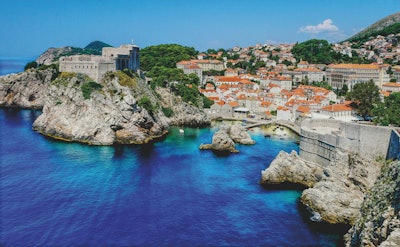
Thinking about treating your team to an all-expenses-paid getaway? It's not just a generous gesture—it's a strategic move to boost happiness, productivity, and camaraderie among your employees.
For many companies, incentive trips are evolving from nice-to-have luxuries to strategic business tools, especially as remote and hybrid work models become the norm. According to this year's Incentive Travel Index—released in October by the Incentive Research Foundation, the Society for Incentive Travel Excellence, and Oxford Economics—there's an anticipated 54% increase in spending on incentive travel for 2025, and businesses are investing an average of $4,900 per person to ensure their top talent feels valued and engaged.
The study adds that 81% of companies use these trips to retain talent, with 62% viewing them as a competitive hiring advantage. So, with incentive trips on the rise, what's working now? Here's what's trending:
1. Balancing leisure and networking
According to the Incentive Travel Index, group dining is the most appreciated activity in an incentive travel program—but it’s followed closely by group cultural sightseeing experiences, activities that promote relationship-building, and free time. (Free time, in fact, jumped four spots from its 2023 rank.)“Right now, what’s interesting is a balance between leisure time and networking time,” agrees Ashley Case, senior director of meetings and incentives operations at travel management company CADENCE. “Time is our most valuable asset, and if [this trip] is a reward, people want some freedom to use their time as they please. It’s about making sure you have enough gaps in the itinerary, and giving them options to curate their own experience—whether that’s cultural, wellness-focused, creative, or anything in between."
These leisure experiences have an added bonus of allowing smaller groups to have more intimate interactions, which Case notes stakeholders appreciate because it can lead to greater value and takeaways. "It also stimulates conversation topics for evening events when everyone comes back together," she points out.
2. Exploring beyond the resort—and leaving the destination better than you found it
While all-inclusive resorts are rising in popularity—42% of buyers expect to use them more in the future, according to the Incentive Travel Index—many companies no longer want to spend all day lounging by the pool.“Many incentive trips in the past were more about going to a resort and never leaving,” notes Gabriella Ribeiro, a tourism marketing expert and the chief exploration officer at travel company Explorateur Journeys. “Now, people want to come back feeling like they've made a change or experienced one, while still having a wonderful time. There are still all the bells and whistles, gorgeous add-ons with exclusive dinners that contribute to the local economy. But now, there's a lot of demand for programs that move away from the base hotel and allow people to experience more of where they are.”
To Ribeiro, it's all about building bridges with local community members and embracing unique experiences, like "partaking in a cooking experience in someone’s home versus a commercial kitchen under fluorescent lights, or engaging with local entrepreneurs and business associations, or leaving a footprint in the form of a volunteer project that makes an immediate impactful difference." It's all about sustainability and working to leave the destination better than you found it, she says.
Of course, when venturing out into the local community or coordinating any volunteer projects, it’s important to work with a local team to ensure you’re doing it in a culturally sensitive way that can actually make a tangible impact. That’s where destination management companies and other local partners can come in.
3. Offering personalized itineraries
One size doesn’t fit all when it comes to trips like this. “A lot of the times, people on incentive trips are of different age ranges, different levels of fitness, different interests,” points out Ribeiro. Offering a variety of itinerary and activity options can make sure everyone feels valued and gets the most out of their experiences. That’s one reason Ribeiro has observed a huge demand for chartered boat experiences, where guests stay on board but can choose between on-shore excursions. “It gives people their exclusive bubble to create the program they want on board, and have brainstorming sessions, fitness classes, etc.—but still be able to island-hop and enjoy the local offerings without the hassle of packing and unpacking all the time.”
Case is all about personalization these days, especially when it comes to gifts and F&B. “We’re doing a lot of monogrammed gifts with names or initials, or opportunities for guests to design their own hats or shoes or wine glasses. We’ve even done custom leather jacket fittings in Argentina, or cowboy hats and belt buckles in the West," she says. "It’s also about personalizing menus. Instead of having a set menu or set buffet, we’re leaning into action stations where people can build their own ramen bowl, or poke bowl, or burrito bowl.”
4. Exploring emerging destinations
An incentive trip destination Ribeiro is excited about now is Croatia, which she says offers an “enriching, authentic experience without the huge crowds you see in places like Italy.” She's also seeing increased interest in Portugal, Malta, and Greece, though she notes that clients are increasingly exploring the less-traveled islands or asking about options in the offseason. And for U.S.-based companies, “the Caribbean and Mexico will always hold appeal for their cost and value."Case agrees that the Caribbean will always be a popular choice, and adds that Hawaii is coming back as a popular destination. “We also see a lot more Europe—Portugal is quite popular right now—but Japan seems to be the hot spot," she says. "It’s of course for the right group that can handle that amount of travel time."
When choosing a destination, safety considerations are at the top of the list, with over 70% of respondents on the Incentive Travel Index citing the importance of a destination that's perceived as safe in terms of personal safety and geopolitical risk. Meanwhile, 70% of buyers are looking into destinations they haven’t used before. “Companies are not going to be in business long if they keep repeating the same programs over and over again,” Ribeiro advises. “They always want to do things differently.”
5. Respecting local etiquette
Our experts stressed that working with local DMCs and other local experts is crucial. "We really collaborate with them about how we can make the experience the most authentic and touch that community in a way that’s impactful,” says Case. “And that’s not just through any dedicated CSR events; it’s about whatever activities we choose. It’s always thinking about how we can reduce the environmental impact, minimize waste, and give jobs to people within the community.”That also means respecting local customs and traditions. “With any incentive, the whole point is to immerse your attendees in that destination,” Case adds. “It’s always about blending the two cultures together, and you have to do that delicately by making sure you’re educating your attendees before you depart about local customs or traditions. I like the trend of having a pre-trip webinar—going through all the pre-trip information and schedule, of course, but also touching on that cultural aspect as well so everyone knows what to expect and will be respectful when walking into someone else’s home environment.”



















